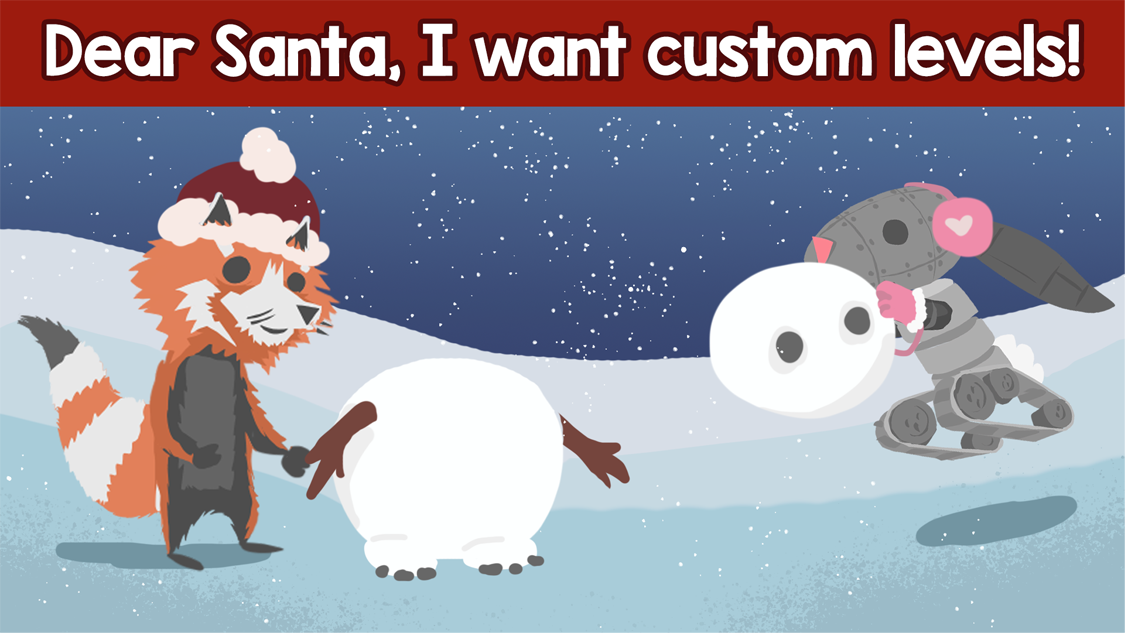Behind the scenes: The flamethrower
/This is part 1 /7 of a series of articles written by Eve, the Clever Endeavour Community Manager, about the making of the A-cobra-tic Update for Ultimate Chicken Horse, which was released in March 2020. Each article will reveal some of the process of making new content for the game, and show in-progress images of each of the A-cobra-tic features that have never been shown to the public before.
The humble flamethrower
The idea of a flamethrower block with an intermittent flame hazard has been around in the Ultimate Chicken Horse community for a long time. In fact, according to our record of Fun Reports, Discord logs, and fan art collection, it might be one of the most suggested additions ever!
For example, here’s the first instance of a flamethrower block mock-up I could find, sent by ZakolakPL on Steam way back in July of 2016:
The illustration indicates alternating on and off states
Then there’s this one sent my Fulandre, also on Steam, but in December of 2017:
we love how this fan art basically shows three animation frames for the flamethrower idea
This design is more analogous to the (mostly harmless) fire hydrant block. It is also is very reminiscent of the flamethrower block idea that Fabio pitched to the team in August of 2019, when we first met to decide what to add to the next update – though the resemblance is purely coincidental:
propane tank + nozzle = flamethrower. everyone knows it.
What was interesting to us about this block design was that, thus far, Ultimate Chicken Horse had been lacking a diagonal hazard. When developing new content for the game, we find it quite valuable to identify the so-called low-hanging fruit, because it means we can get a lot of value from an addition that is simple to make. It doesn’t cause us headaches to get working, while giving our fans something new. It’s a win-win!
Essentially, we immediately agreed to make this block, but decided that the design we wanted would be different in some ways:
The silhouette and details would need to be simpler and fit the grid better, in keeping with the overall aesthetic of blocks in Ultimate Chicken Horse.
Similarly, the colors would be brighter to fit the usual palette.
Unlike the mock-up, the flame would exactly occupy two diagonal squares on the placement grid.
The block itself would fit in a single square to facilitate its placement and rotation.
Following these guidelines, here’s the concept Fabio came up with next:
ᘛ⁐̤ᕐᐷ
The most astute observers will notice two things:
This is CUTE AS HECK
… and yet, it’s not the design we ended up using!
I honestly expect some amount of outcry about that design decision. Why oh why did we not go with this adorable little animation? I mean, look at the little thing *go*, right?!
However, the fact that it’s a perfectly lovely animation by itself does not mean that it works well in the game! We had multiple concerns about it, and I hope that I can help you agree with us with a bit of explanation.
First, the design surely is easily recognizable as a lighter, yet the proportions are clearly off, which makes it look somewhat uncanny. It manages to be both way too small (given how short it is), and way too big (compared to the game characters, or even that mouse).
Also, while we were all enamored with the animation at first, we quickly realized that looping it over and over, as we needed to do in the game, made the cute mouse look less like a lively creature, and more like some sort of mind-controlled automaton doomed to repeat the same movement at a steady interval for all of eternity. Yikes.
You can see that in the GIF below, along with an even bigger issue: When the block was rotated, the mouse’s orientation with regards to gravity defied the laws of physics in a jarring way. The ability to flip blocks is central to Ultimate Chicken Horse, so we want all blocks to make (relative) sense no matter their orientation.
well this is awkward
Finally, we also saw an issue with what the block design was communicating to the player. If the mouse could press the button to light the flame, then players might have expected to be able to do the same – like with the punching glove block, which has similar-looking buttons that players can press. The potential confusion was even more striking when we experimented with removing the mouse automaton. That was our biggest issue with this version of the block: we wanted the flamethrower to be automatic and predictable, and the visuals failed to telegraph that clearly if they suggested the block could be activated by player intervention.
With all that in mind, we returned to the basics and moved on to what became our winning flamethrower design, while keeping the same flame animation:
fwoosh!
This little device tacked onto a propane tank is not exactly cute, but it works so well! Most people would know to expect fire from it, and the dial indicates that it’s both automated and predictable. The design also makes equal sense if you rotate the block in any direction.
The final flamethrower has some additional benefits compared to the lighter, both in ways that are specific to the needs of our game, and ways that boil down to basic animation principles.
With regards to in-game functionality, the animation remains smooth and accurate if you increase or decrease the Game Speed by using Modifiers, whereas the mouse’s organic movement stopped making sense if you modified the speed in either direction.
When it comes to the readability of the animation, the flamethrower holds a couple advantages. First, the position of the nozzle more clearly indicates that the flame will come out at an angle, unlike the lighter, which one could have expected to have a normal, vertical flame. Second, the silhouette is much more distinct.
It’s a well-known animation fact that a character or object’s silhouette benefits from being as clear and expressive as possible, in order to help the viewer make sense of what they’re seeing. In the context of Ultimate Chicken Horse, this is an interesting consideration, because it has to be balanced against another constraint, which is that we want our blocks to fit and fill squares on the grid as closely as possible, both visually and physically, to make placement and platforming on all blocks seamless. Arguably, the lighter design occupies one square of the grid with more fidelity than the flamethrower. However, the flamethrower is definitely not far from a snug fit, while also having more distinct features.
It might seem needlessly pedantic to want to make the art of our silly game adhere to idealistic animation principles. While I could actually make a convincing argument about how it’s generally a good idea to aim for high standards of readability in fast-paced video games, there’s also one other reason why this is of particular importance in Ultimate Chicken Horse. And that reason… is Dance Party.
you love to see it
You see, this level everybody loves dearly (*ahem*) turns everything into literal silhouette animation of black shapes on a lighter background. In this context, having clear and easily distinguishable block silhouettes is crucial to avoid creating (more) frustration.
lighter silhouette
flamethrower silhouette
The image on the left shows the old lighter on Dance Party, right next to a 1x1 block. The two are not very different. What’s more, it’s pretty hard to tell what the lighter even is!
In contrast, the flamethrower in the right image could not be mistaken for a simple 1x1 platform. You might not be able to tell exactly what it is if you didn’t already know, but the nozzle sticking out nevertheless indicates that this must be the business end, and something will happen there.
Now, to be clear, I would be lying if I said that we held all of these considerations in mind from the very beginning. We stumbled upon them as we prototyped the block and iterated on its design.
That being said, this whole process is a very good illustration of how much thought goes into creating any bit of content to add to Ultimate Chicken Horse – even if it’s something mechanically simple like the humble flamethrower. As it turns out, this block required us to pay attention to a lot of visual details in order to get to a design that really works for the game.
We hope you enjoyed this first behind-the-scenes article! The next one will be about the star of A-cobra-tic: the Snake character, and will be posted in a week. See you then!



















